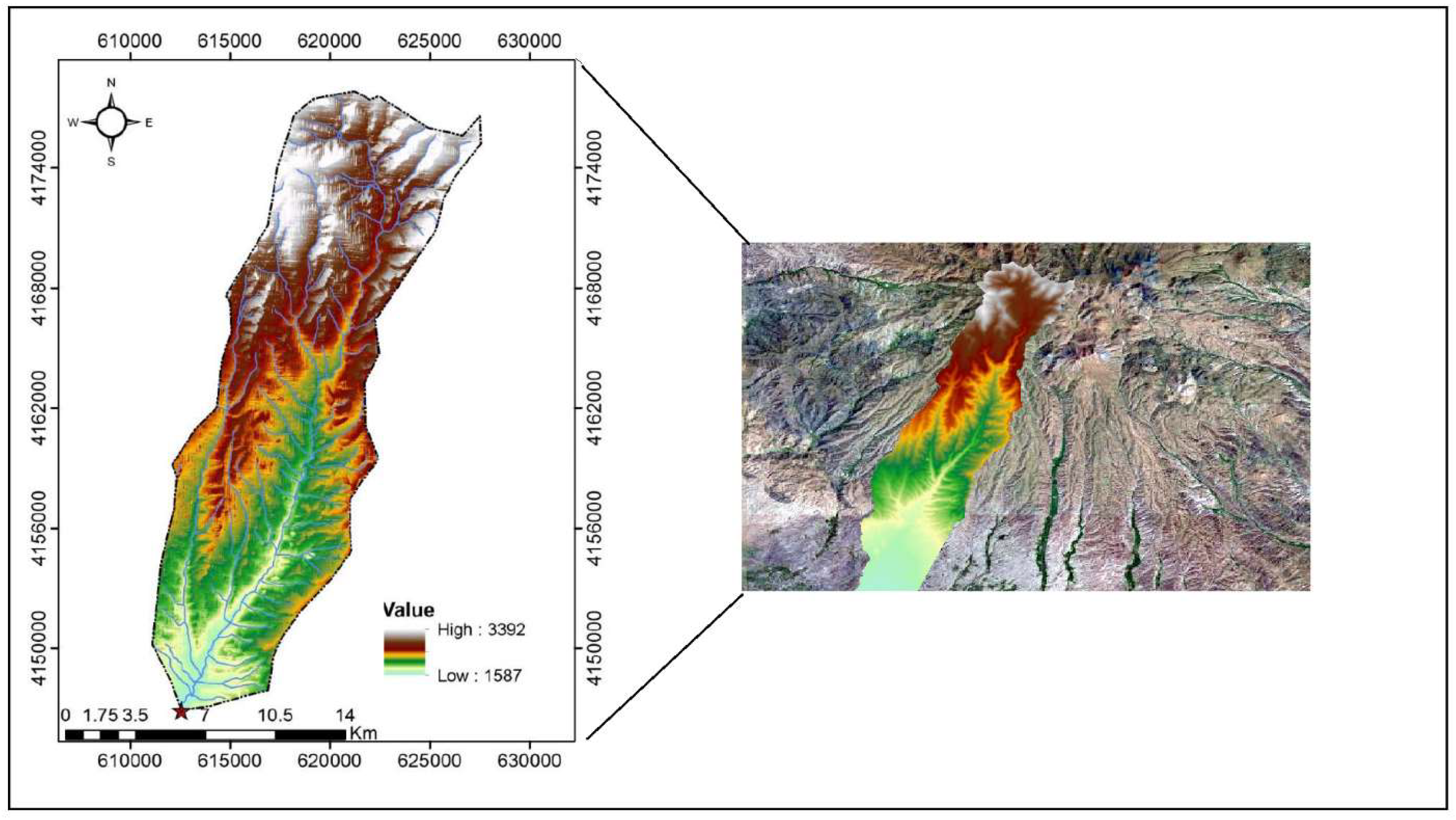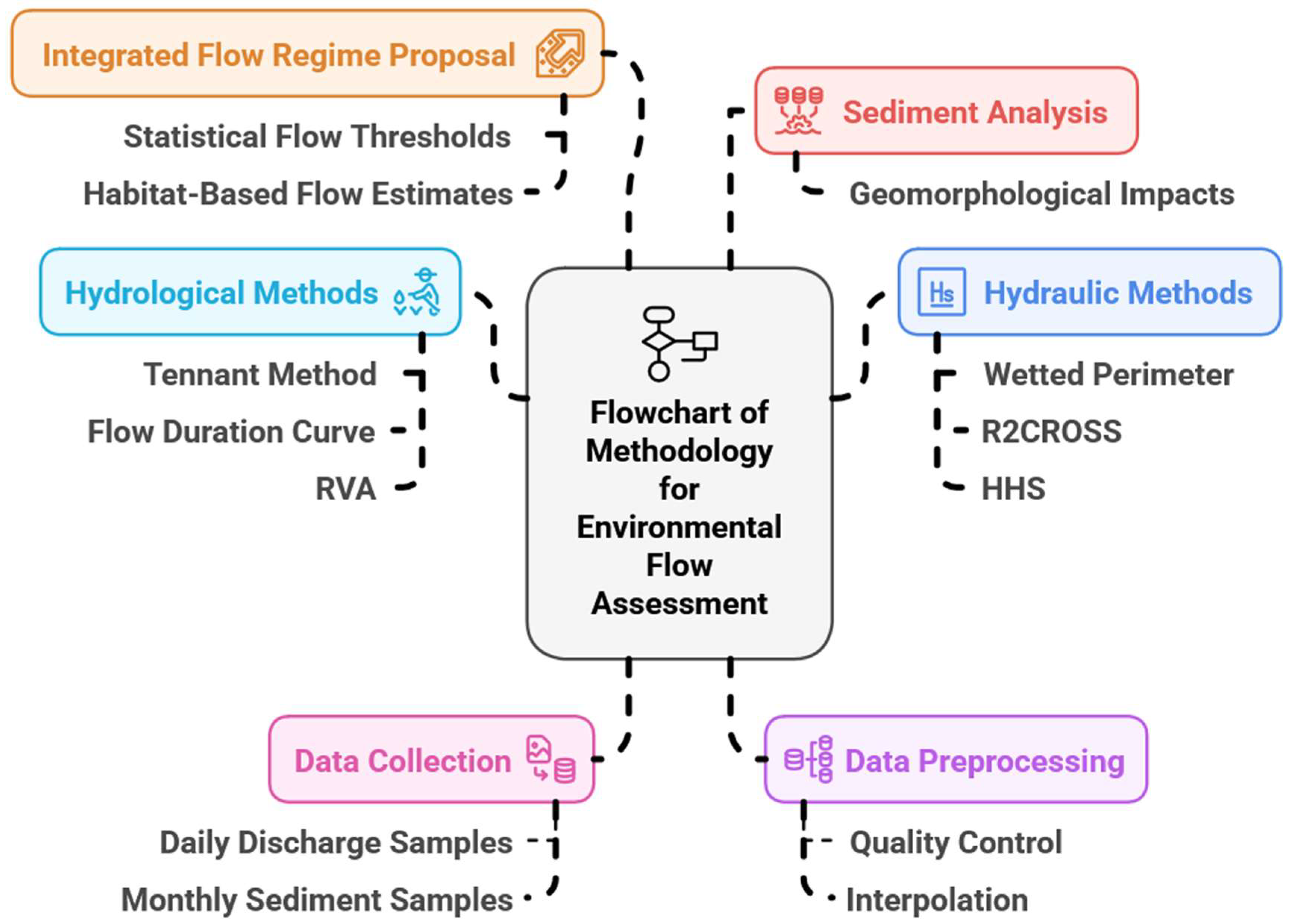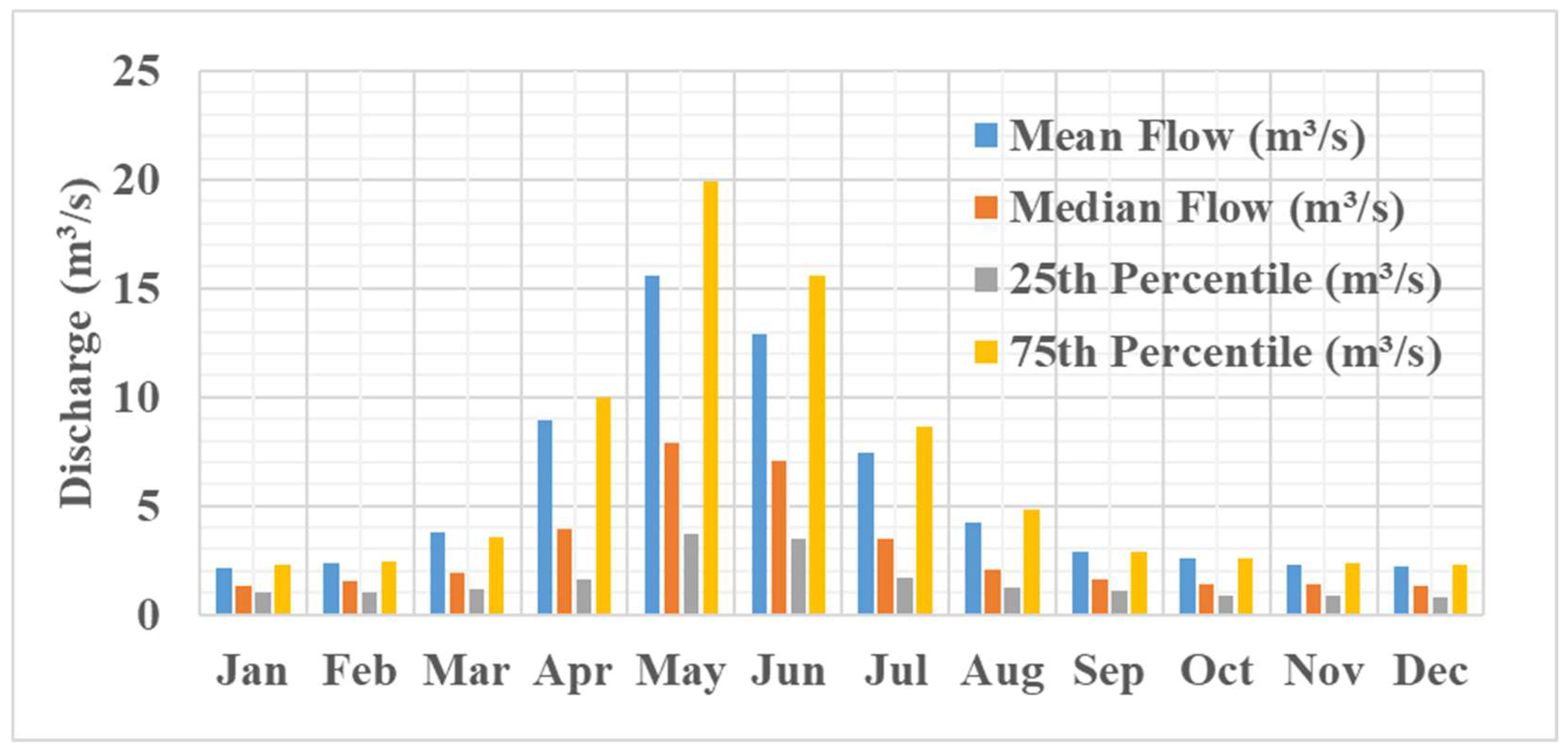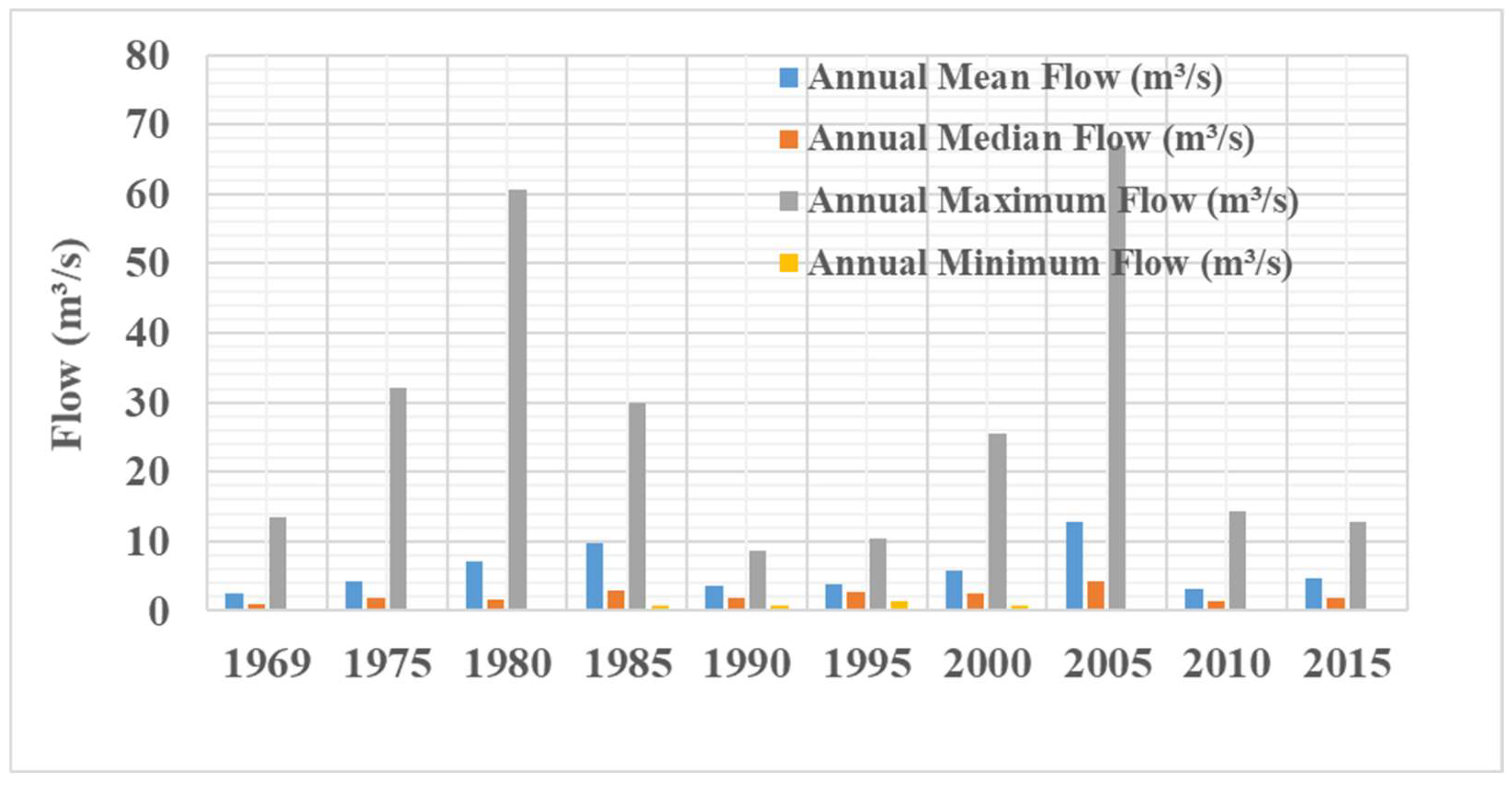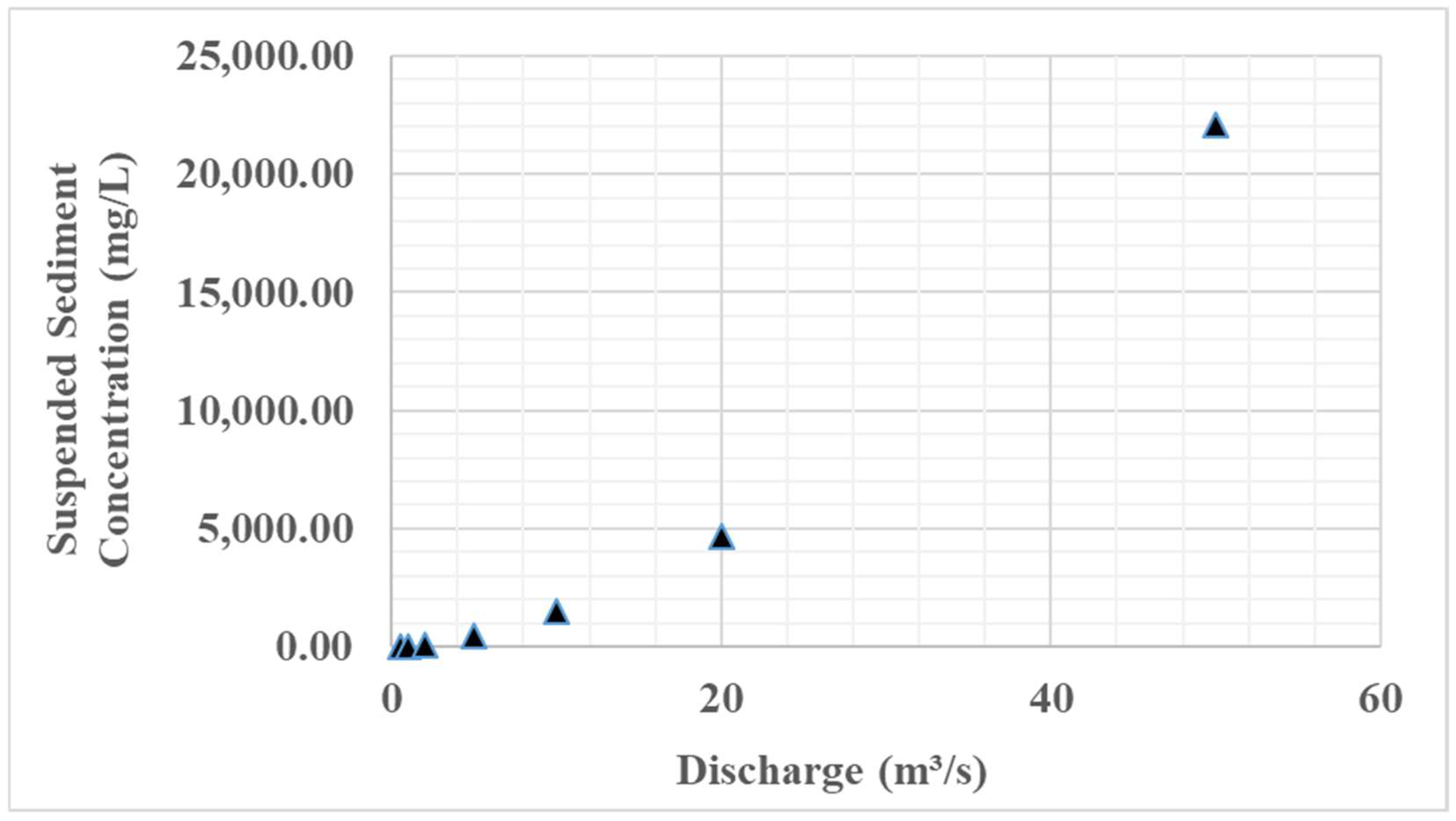The dataset spans between 1969 and 2018; thus, it is very extensive and can serve as a strong foundation for the examination of the river’s requirements regarding environmental flow. Given this, a number of methodologies were applied in establishing the environmental flow requirements. These methodologies included hydrological approaches, hydraulic rating methods, habitat simulation techniques, and integrated approaches. As a result, several methodologies were applied to ensure that the environmental flow demands of the river were comprehensively analyzed.
3.1. Hydrological Methods
The hydrological methodologies were initiated with the application of the Tennant method, sometimes called the Montana method, being arguably the most straightforward and efficient. This latter method proposes various percentages of mean annual flow that correspond to different levels of habitat quality. Using the available flow data, we calculated the mean annual flow for the Sofi Chay River. The Tennant method demonstrated that 30% MAF maintains a good quality habitat, while a minimum flow of at least 10% of MAF sustains the short-term survival of most aquatic life. Then, the Range of Variability Approach using Indicators of Hydrologic Alteration was used to develop the flow objectives. This approach considers natural variability inherent in flow regimes that is essential to the maintenance of healthy ecosystems.
The models employed here, such as the Range of Variability Approach (RVA) and Indicators of Hydrologic Alteration (IHA), are holistic frameworks that quantify natural flow variability through statistical metrics of magnitude, timing, frequency, duration, and rate of change, derived from historical data. To further capture this variability, stochastic methods like Autoregressive Moving Average (ARMA) and Autoregressive Fractionally Integrated Moving Average (ARFIMA) models are highly relevant. These methods are designed to simulate and forecast streamflow by modeling fractal behaviors and long-term persistence, effectively representing a significant portion of observed variability. Such stochastic approaches align with the IAHS scientific vision outlined in Montanari et al. (2013), which emphasizes understanding hydrological change and variability in the context of societal needs, enhancing the robustness of environmental flow assessments in this study. We analyzed historical flow data to identify important flow characteristics, including magnitude, timing, frequency, duration, and rate of change from flow events. The results from these analyses are presented with reference to revised tables for clarity. For instance,
Table 2 outlines the flow recommendations provided by the Tennant method, based on 18,262 daily discharge samples collected from 1969 to 2018, with habitat quality categories sourced from Tennant (1976).
Table 3 has been expanded to report mean monthly flows derived from the same 50-year dataset of 18,262 daily observations, specifying the collection period (1969–2018) and sample frequency (daily). To enhance our understanding of temporal variability, a one-way analysis of variance (ANOVA) was conducted on monthly flows across the 50 years, revealing significant differences (F(11, 59,988) = 142.3,
p < 0.001), with peak flows in April–June (mean = 9.45 m
3/s) that were significantly higher than August–February flows (mean = 2.22 m
3/s), as confirmed by Tukey’s post hoc test (
p < 0.05). These findings, as detailed in
Table 3, underscore the seasonal variability critical to environmental flow planning.
Another approach we applied was the holistic Building Block Methodology (BBM). It involved the bottom-up construction of a flow regime, considering different ecosystem components and their flow requirements. Through expert judgment and available hydrological data, we identified the critical flow events required to maintain river health, such as low flows, freshes, and flood events. These were complemented by the consideration of ELOHA, the ecological limits of hydrologic alteration framework. In this approach, the integration of hydrologic and ecological data develops flow–ecology relationships. Another method included the classification of the river based on its flow regime and geomorphology to estimate the probable impacts of flow alterations on ecological conditions. Addressing the habitat simulation techniques, the framework of Instream Flow Incremental Methodology or IFIM was utilized. While this approach typically requires comprehensive field measurements of hydraulic and habitat variables, reasonable assumptions can be made from the flow and sediment data already available. The methodology allows the linkage of flow alterations to habitat availability for target species, hence providing a more ecologically relevant assessment of flow requirements.
A proper quantitative analysis of the environmental flow requirements for Sofi Chay River cannot be achieved without summarizing the key hydrological characteristics of the river based on the dataset provided.
Table 1 shows the basic statistical parameters of flow data.
To conduct a comprehensive quantitative analysis of the environmental flow requirements for the Sofi Chay River, firstly, we needed to summarize the key hydrological characteristics of the river based on the provided dataset.
Table 2 presents the basic statistical parameters of the flow data.
The large range of flow values and high standard deviation values are indicative of great variability in the river’s discharge, a critical consideration in determining environmental flow requirements. By applying the Tennant method, it was possible to make an estimation of different levels of environmental flow with various percentages against the MAF.
Table 3 shows the recommended flow regimes.
These values can be used as a starting point for environmental flow management, and the flows must not go below 0.94 m
3/s, at which basic ecological functions can still operate. This can also be analyzed for its seasonal variability, which is usually performed in similar studies.
Table 4 summarizes the monthly flow pattern averaged over a month.
This monthly distribution therefore shows a marked seasonality in the flow, with peak flows during the spring months of April to June, while the low flows are in late summer and winter. Any recommendations on environmental flows, therefore, must relate to this natural variability in supporting ecosystem processes adapted to these changes in seasonality. Detailed recommendations using the Range of Variability Approach have identified key flow components and their variability. Some selected Indicators of Hydrologic Alteration (IHA) parameters are given in
Table 5.
These IHA parameters are targets for maintaining natural flow variability. In recommendations for environmental flows, the aim should be to keep flows within the 25th percentile to 75th percentile of each of these parameters in order to sustain ecological integrity.
In order to implement the BBM (Building Block Methodology), the critical flow component has to be identified. From the flow analysis and general ecosystem requirements, an environmental flow regime is given in
Table 6.
The regime was designed to replicate sequences of natural flows in a manner that would enable the continuance of main ecological processes such as fish spawning, sediment flushing, and maintenance of riparian vegetation. The FDC will complement our understanding of the Sofi Chay River flow regime and its implications for environmental flow requirements. An FDC conveys important information on overall flow characteristics of the river, which is considered useful within the context of environmental flow assessments. Key points on the FDC are given in
Table 7.
According to the FDC, the river has a big flow variability. It can be noticed that Q5 is almost 87 times the value of Q95; this is very important for the diverse aquatic habitats and ecological processes maintenance. The recommendations for environmental flow should support the maintenance of the degree of variability in a way that ensures that low flows do not fall below critical thresholds.
Given the availability of 50 years of streamflow data (1969–2018), a probability distribution function (PDF) fitting was conducted to model the flow regime more robustly, as shown in
Figure 2. Following the approach suggested by Dimitriadis et al. (2021), distributions such as Weibull, log-normal, and Pareto–Burr–Feller were tested, with the Pareto–Burr–Feller distribution providing the best fit (based on the Kolmogorov–Smirnov test,
p = 0.92). This theoretical PDF was used to estimate key statistical values, including quantiles (e.g., Q5 = 36.12 m
3/s, Q95 = 0.39 m
3/s), rather than relying on empirical data, thereby minimizing statistical biases inherent in the sample. This approach ensures that environmental flow estimations, such as those critical for habitat maintenance, are derived from a statistically consistent framework, enhancing the reliability of the proposed flow regime. The Flow Duration Curve (FDC) in
Figure 3 summarizes data on the flow regime of this river.
Monthly flow statistics provide important data for developing seasonably appropriate environmental flow recommendations. The data show a marked seasonality with peak flows during spring months of April, May, and June, while during late summer and winter, the area faces low flows. In fact, this seasonal variability in river flow is conducive to several ecological processes such as fish spawning, sediment transport, and maintenance of riparian vegetation. Analysis of the monthly flow statistics shows a distinct seasonal pattern. The coefficient of variation (CV) in the monthly mean flows is 0.84, indicating that monthly flows are highly variable seasonally. The ratio of maximum to minimum monthly median flows is 6.14 (7.86/1.28), with further emphasis on the need for environmental flow recommendations to consider seasonality. A Q95 flow of 0.41 m
3/s from the FDC could be considered as a potential minimum environmental flow during dry periods. This, however, needs to be checked against the habitat requirements of key species. The monthly 75th percentile flows that range between 9.97 and 19.92 m
3/s in these high-flow months of April to June are significant for channel maintenance and, therefore, need factoring into environmental flow recommendations. The Baseflow Index was computed as the Q90 to mean annual flow ratio = 0.65/9.37 = 0.069, which was relatively low. The Baseflow Index is indicative of a high surface runoff contribution; thus, sustaining variability in flow becomes paramount (
Figure 4).
The annual flow statistics shown in
Figure 5 are characterized by high inter-annual variability. In fact, the coefficient of variation for annual mean flows is 0.58, which is highly variable from year to year. It also means that any environmental flow recommendations may have to be flexible enough to capture this wet and dry year variability. Comparing the annual median flows given in
Figure 5 with the overall median flow of 2.07 m
3/s obtained from the previous FDC analysis gives an indication of the year-to-year variability. The years with median flows appreciably below this value, for instance, the years 1969 and 1975, may require special consideration in environmental flow planning to guarantee the resilience in ecosystems during low-flow conditions. We tried to further refine our environmental flow recommendations, applying the Ecological Limits of Hydrologic Alteration (ELOHA) framework. In that direction, we needed to develop some flow–ecology relationships. Detailed ecological data are not available; hence, we used generalized relationships from similar river systems. A hypothetical flow–ecology relationship for key ecological indicators is presented in
Table 8.
While these relationships are hypothetical, they form a basis for establishing flow targets that are supportive of multiple ecological objectives. For instance, maintenance of Q90 flows > 1.5 m
3/s supports native fish diversity, while annual floods reaching > 50 m
3/s support healthy riparian vegetation. Another way of looking into the sediment dynamics of the river, which is very important in maintaining channel morphology and habitat quality, is by analyzing the relationship between flow and SSC. From the data available in this study, a sediment rating curve that relates discharge to the concentration of suspended sediment can be plotted. Some of the results of this analysis are presented in
Table 9.
This relationship shows that sediment transport increases more than proportionally with discharge, which indicates that higher discharges are important for geomorphological processes. It might also suggest that there was excessive sedimentation below 1 m3/s and a particular role of flow above 10 m3/s in sediment flushing and channel maintenance.
Figure 6 presents the relationship between discharge and suspended sediment concentration, which is of vital importance in understanding the geomorphological implication of various flow regimes. Data herein presented can be employed to develop a sediment rating curve, which again becomes highly significant to determine the flows that are a requisite for channel maintenance and sediment flushing. The relationship between discharge and suspended sediment concentration can be described by the power function SSC = 14.23 × Q
1.68 (R
2 = 0.99). It follows from this relationship that increases in discharge are accompanied by more than a proportional increase in sediment transport, underlining the particular importance of higher flows for the maintenance of geomorphological processes. These various analyses are integrated here to suggest a holistic environmental flow regime considering multiple ecological and geomorphological objectives.
Table 10 summarizes this proposed regime.
The Tessman method expands the Tennant method to include variation in monthly flow. The mean monthly flows were determined and related to the mean annual flow. Thus, the different recommendations on environmental flow varied within months from 0.53 m3/s to 5.32 m3/s, depending on the hydrological characteristics of any given month. The Q95 Method calculates the 95th percentile of flow duration curve for the minimum requirement of environmental flow. The minimum environmental flow requirement for this method is 0.65 m3/s. The different calculation techniques used in this study give a range of environmental flow recommendations for the Sofi Chay River: ranging from 0.53 m3/s as the minimum flow for poor habitat conditions according to the Tennant method to a 0.65 m3/s minimum according to Q95. The Flow Duration Curve and RVA methods go further, taking into account the variation in flow and other habitat ecosystem needs aside from minimum flows. The range of variability approach is the most comprehensive in stating the flow requirements since it encompasses most aspects of the flow regime relevant for ecosystem health. On the other hand, its application requires thorough consideration of the trade-offs between the human need for water and the environmental needs. It is relevant to point out that these hydrological methods do not take into consideration the precise ecological needs of local species or geomorphological processes. In fact, such results should be regarded as initial estimates and must be refined through ecological studies and consultations with local stakeholders. Hydrological methodologies do indicate that the minimum flow should be maintained constantly at 0.65 m3/s, using the Q95 method, to support basic ecological functioning. However, good-to-optimum habitat conditions require flow management to replicate natural variability with higher flows in the wet season and careful flow management during dry periods. Adopting the adaptive management approach was also recommended, whereby these initial flow recommendations are implemented and monitored for ecological responses. This will, over time, allow the refinement of the environmental flow allocations, thus ensuring the long-term health of the Sofi Chay River ecosystem while at the same time balancing human water needs.
3.2. Hydraulic Methods
An attempt was made to employ three most well-known hydraulic methods for environmental flow assessment: the Wetted Perimeter Method, R2CROSS Method, Manning’s Equation Method, Hydraulic Habitat Simulation Method, Power Law Method, and Hydraulic Geometry Method. The Wetted Perimeter Method relates the wetted perimeter of a river cross-section to discharge. The point showing maximum curvature on the wetted perimeter–discharge curve is normally considered as the minimum environmental flow. The wetted perimeter (P) for a trapezoidal channel is calculated in Equation (1).
where b = bottom width of the channel (m), y = water depth (m) and z = side slope (horizontal:vertical).
The R2CROSS method uses three hydraulic parameters to determine environmental flow:
(a) Average depth (d) ≥ 0.2 ft (0.061 m); (b) average velocity (v) ≥ 1 ft/s (0.3048 m/s); (c) wetted perimeter ≥ 50% of bankfull wetted perimeter.
The discharge that meets all three criteria is considered the minimum environmental flow.
Manning’s equation relates flow velocity to channel characteristics according to Equation (2).
where v = velocity (m/s), n = Manning’s roughness coefficient, R = hydraulic radius (m) = A/P, A = cross-sectional area (m
2), P = wetted perimeter (m), and S = channel slope.
The discharge (Q) is then calculated as Q = A × v.
To apply these methods, average cross-sectional data of the river were applied as follows:
Bottom width (b) = 10 m; side slope (z) = 2; channel slope (S) = 0.001; Manning’s n = 0.035.
Discussion and Analysis: From the wetted perimeter versus discharge relationship, it can be seen that the maximum point of curvature is close to the 0.4 m depth that corresponds to a value of about 1.60 m
3/s. In the R2CROSS Method, the discharge that meets the three criteria of depth ≥ 0.061 m, velocity ≥ 0.3048 m/s, and wetted perimeter ≥ 50% of bankfull is approximately 3.23 m
3/s at a depth of 0.6 m. This enables the computation of discharge for different depths using Manning’s equation. The specific habitat requirements for minimum environmental flow may vary, but generally, for instance, depths (0.4 m) that keep all pools interconnected can be adopted, corresponding to a discharge of 1.60 m
3/s (
Table 11).
All the hydraulic methods give various environmental flow recommendations, ranging between 0.98 and 4.40 m3/s for the Sofi Chay River. The Wetted Perimeter Method gives the minimum flow of 1.60 m3/s, matching Manning’s Equation Method at a depth of 0.4 m. Among the hydraulic methods, R2CROSS is the only method that can take more than one hydraulic parameter into account and gives a higher flow amount of 3.23 m3/s. This hydraulic analysis showed that the minimum environmental flow required to maintain basic ecological functioning of the Sofi Chay River is within the range of 1.60–3.23 m3/s. A more valid recommendation would, however, include a flow regime with temporal variability as in nature. It is thus recommended that an adaptive management approach be followed in which these initial flow recommendations are implemented and monitored to form ecological responses. It enables the development and refinement of environmental flow allocations over time, allowing for the long-term health of the ecosystem of the Sofi Chay River with consideration of human water needs.
Hydraulic Habitat Simulation Method: It is based on hydraulic modeling in combination with the habitat suitability criteria for target species. This uses the concept of Weighted Usable Area to quantify habitat quality at different flows.
The WUA is calculated as Equation (3).
where Ai = area of cell i and CSIi = Composite Suitability Index for cell i.
The CSI is typically calculated as Equation (4).
where HSI values are depth, velocity, and substrate habitat suitability indices.
With a focus on target fish species, the following habitat suitability criteria can be achieved (
Table 12).
Utilizing the cross-sectional data presented in
Table 10 and the HSI values computed herein, the WUAs for various discharges were calculated and are presented in
Table 13.
The environmental flow that maximizes the WUA is roughly 5.38 m3/s.
The Power Law Method relates habitat quality to discharge with a power function in the form of Equation (5).
where H = habitat quality metric, Q = discharge a; b = empirically derived coefficients.
For the Sofichay River, the empirically derived equation between habitat quality and discharge took the form of H = 2 × Q0.4.
Thus, the results of habitat quality for various discharges have been calculated and are presented in
Table 14.
The Hydraulic Geometry Method uses empirical relations between channel dimensions and discharge, as presented in Equation (6).
where w = channel width, d = channel depth, v = flow velocity, Q = discharge a, b, c, f, k; m = empirically derived coefficients.
Then, it is possible to calculate channel dimensions for different discharges (
Table 15).
In this instance, environmental flow would be chosen according to target channel dimensions supporting ecosystem functions. These hydraulic methods provide further detail on the environmental flow needs of the Sofi Chay River. The Hydraulic Habitat Simulation Method provides a suggested optimum flow of approximately 5.38 m3/s, which maximizes the Weighted Usable Area for our hypothetical target species. This is higher than the recommendations derived from the previous two methods and emphasizes that specific species needs are paramount. The Power Law Method provides a continuous relationship between discharge and habitat quality, thus allowing managers to make informed decisions based upon the desired habitat conditions. In our example, habitat quality continues to increase with discharge, but at a diminishing rate. The Hydraulic Geometry Method provides an overview of the variation in channel dimensions with discharge. In particular, this is useful to consider various flow regimes that may affect channel morphology and habitat availability throughout time. These methods are all based on empirical relationships and habitat suitability criteria that must be developed for the Sofi Chay River and its ecosystem. Hypothetical data are used here to illustrate the methods, but actual applications would require substantial field studies and data collection. These additional hydraulic approaches further reinforce the complexity that is inherent in environmental flow assessment. While our base analysis resulted in a minimum flow range of 1.60–3.23 m3/s, these methods indicate that higher flows may be necessary, in the order of 5.38 m3/s or more, to optimize habitat conditions for some species.
3.3. Comparison Between Different Methods
The present analysis tries to compare the hydraulic and hydrologic approaches used for assessment of the environmental flow requirements of the Sofi Chay River. Such a comparison will be able to outline the strengths and weaknesses of each approach regarding the existing data and specific characteristics of the Sofi Chay River ecosystem. In general, the hydrological methods recommended lower environmental flows compared to the hydraulic methods. The hydrological methods proposed here were Tennant, Flow Duration Curve, RVA, Tessman, and Q95, while the hydraulic methods were Wetted Perimeter, R2CROSS, Manning’s Equation, Hydraulic Habitat Simulation, Power Law, and Hydraulic Geometry. The hydrological methods recommended minimum flows ranging from 0.53 m3/s for Tennant’s poor habitat condition to 2.66 m3/s for Tennant’s outstanding habitat condition. In comparison, the hydraulic methods for stream flow predictions ranged from 1.60 m3/s using Wetted Perimeter and Manning’s Equation to 5.38 m3/s using Hydraulic Habitat Simulation. This finding reflects the basic difference in approach: hydrological methods rely on historical flow data alone, whereas hydraulic methods take on board physical habitat characteristics and their relationship to discharge. Higher flow recommendations from hydraulic methods indicate that maintenance of adequate physical habitat conditions in Sofi Chay River may require more water than reported if one were to consider historical flow statistics alone.
For the Sofi Chay River, a combination of methods appears to be the most appropriate in the investigation for superior methods.
The Range of Variability Approach (RVA) developed from hydrological methods has its usefulness in estimating the variability in natural flow that is integral for ecosystem integrity. It advocates that flows should be maintained within ± 1 standard deviation of their long-term means for various flow parameters.
Among those presented herein, the Hydraulic Habitat Simulation Method, if appropriately parameterized with local data, allows the deepest analysis of flow-habitat relationships. Its recommendation of 5.38 m3/s, so as to maximize Weighted Usable Area, does provide a target for optimal habitat conditions.
The Wetted Perimeter Method (1.60 m3/s) provides a practical minimum flow threshold that ensures basic connectivity in the river channel.
Integration of these approaches into a holistic method allows the consideration of both long-term flow pattern and specific habitat needs. The RVA can guide overall flow management with regard to maintaining natural variability, while the Hydraulic Habitat Simulation Method can be used to inform seasonal flow targets. In turn, the Wetted Perimeter Method may provide the lower bound of critical low-flow periods. To illustrate these differences quantitatively, below we compare the coefficient of variation of flow recommendations:
Hydrological Method variation of CV: 0.68 based on recommendation, which varies from 0.53 to 2.66 m3/s
Hydraulic Method variation of CV: 0.52 based on recommendation, which varies from 1.60 to 5.38 m3/s.
The hydraulic method variation is less, which means these methods are closer to their recommendations, arguably because most of them are based on physical habitat conditions rather than statistical flow properties.
Ratios of the recommended flow against MAF 5.32 m3/s.
Therefore, this comparison suggests that the hydraulic methods have a tendency to keep a higher share of the natural flow regime for the environment. The integrated approach of hydrological and hydraulic methods develops a strong platform in the estimation of environmental flows in Sofi Chay River. In this way, while the hydrological methods provide information on the long-term pattern of flow, hydraulic methods give complementary information on habitat–flow relationships. The fact that hydraulic methods recommend higher flows up to 101% MAF, compared with hydrological methods that recommend flows up to 50% MAF, would indicate that, in fact, more water is required than reported by the use of historical flow statistics in isolation to maintain adequate physical habitats in the Sofi Chay River.
